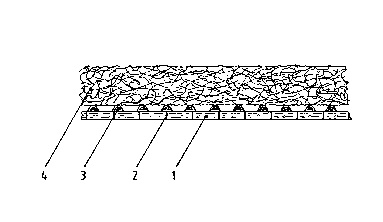Some of the information on this Web page has been provided by external sources. The Government of Canada is not responsible for the accuracy, reliability or currency of the information supplied by external sources. Users wishing to rely upon this information should consult directly with the source of the information. Content provided by external sources is not subject to official languages, privacy and accessibility requirements.
Any discrepancies in the text and image of the Claims and Abstract are due to differing posting times. Text of the Claims and Abstract are posted:
| (12) Patent: | (11) CA 2074768 |
|---|---|
| (54) English Title: | FLEECE LAMINATE HAVING HIGH SPECIFIC VOLUME AND GOOD STRENGTH |
| (54) French Title: | PRODUIT MOLLETON A VOLUME SPECIFIQUE ELEVE ET BONNE CARACTERISTIQUE DE RESISTANCE |
| Status: | Expired and beyond the Period of Reversal |
| (51) International Patent Classification (IPC): |
|
|---|---|
| (72) Inventors : |
|
| (73) Owners : |
|
| (71) Applicants : |
|
| (74) Agent: | BORDEN LADNER GERVAIS LLP |
| (74) Associate agent: | |
| (45) Issued: | 2000-01-25 |
| (22) Filed Date: | 1992-07-28 |
| (41) Open to Public Inspection: | 1993-01-31 |
| Examination requested: | 1992-07-28 |
| Availability of licence: | N/A |
| Dedicated to the Public: | N/A |
| (25) Language of filing: | English |
| Patent Cooperation Treaty (PCT): | No |
|---|
| (30) Application Priority Data: | ||||||
|---|---|---|---|---|---|---|
|
ABSTRACT
A fleece laminate includes a filler fleece and a thread reinforced
fleece and has a total thickness of more than 2 mm. The filler fleece
has a low specific volume, a raw density of below 0.025 g/cm3 and a
thickness of 1.6 to 60 mm. The thread reinforced fleece is composed of
10 to 60 g/m2 fleece material having a raw density above 0.035 g/cm3
and 3 to 100 g/m2 of a thread reinforcement. The laminate has a high
strength in the warp direction. A fleece laminate of large volume is
achieved without the reduction in volume and high density observed in
conventional reinforced filler fleeces.
Note: Claims are shown in the official language in which they were submitted.
Note: Descriptions are shown in the official language in which they were submitted.

2024-08-01:As part of the Next Generation Patents (NGP) transition, the Canadian Patents Database (CPD) now contains a more detailed Event History, which replicates the Event Log of our new back-office solution.
Please note that "Inactive:" events refers to events no longer in use in our new back-office solution.
For a clearer understanding of the status of the application/patent presented on this page, the site Disclaimer , as well as the definitions for Patent , Event History , Maintenance Fee and Payment History should be consulted.
| Description | Date |
|---|---|
| Time Limit for Reversal Expired | 2003-07-28 |
| Letter Sent | 2002-07-29 |
| Grant by Issuance | 2000-01-25 |
| Inactive: Cover page published | 2000-01-24 |
| Inactive: Final fee received | 1999-10-22 |
| Pre-grant | 1999-10-22 |
| Notice of Allowance is Issued | 1999-04-29 |
| Letter Sent | 1999-04-29 |
| Notice of Allowance is Issued | 1999-04-29 |
| Inactive: Inventor deleted | 1999-04-27 |
| Inactive: Approved for allowance (AFA) | 1999-04-15 |
| Inactive: Delete abandonment | 1998-12-15 |
| Inactive: Abandoned - No reply to s.30(2) Rules requisition | 1998-10-19 |
| Amendment Received - Voluntary Amendment | 1998-09-10 |
| Inactive: S.30(2) Rules - Examiner requisition | 1998-04-17 |
| Inactive: Application prosecuted on TS as of Log entry date | 1997-08-22 |
| Inactive: Status info is complete as of Log entry date | 1997-08-22 |
| Application Published (Open to Public Inspection) | 1993-01-31 |
| Request for Examination Requirements Determined Compliant | 1992-07-28 |
| All Requirements for Examination Determined Compliant | 1992-07-28 |
There is no abandonment history.
The last payment was received on 1999-06-18
Note : If the full payment has not been received on or before the date indicated, a further fee may be required which may be one of the following
Please refer to the CIPO Patent Fees web page to see all current fee amounts.
| Fee Type | Anniversary Year | Due Date | Paid Date |
|---|---|---|---|
| Request for examination - standard | 1992-07-28 | ||
| MF (application, 5th anniv.) - standard | 05 | 1997-07-28 | 1997-06-18 |
| MF (application, 6th anniv.) - standard | 06 | 1998-07-28 | 1998-06-23 |
| MF (application, 7th anniv.) - standard | 07 | 1999-07-28 | 1999-06-18 |
| Final fee - standard | 1999-10-22 | ||
| MF (patent, 8th anniv.) - standard | 2000-07-28 | 2000-06-13 | |
| MF (patent, 9th anniv.) - standard | 2001-07-30 | 2001-06-14 |
Note: Records showing the ownership history in alphabetical order.
| Current Owners on Record |
|---|
| CARL FREUDENBERG |
| Past Owners on Record |
|---|
| HANS CLAUS ASSENT |
| JURGEN KNOKE |
| MANFRED JOST |